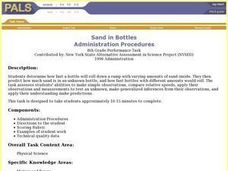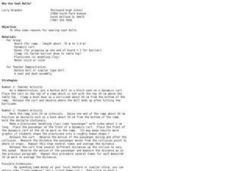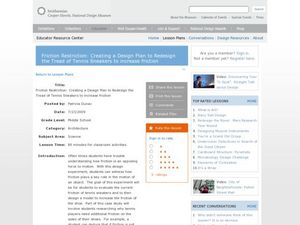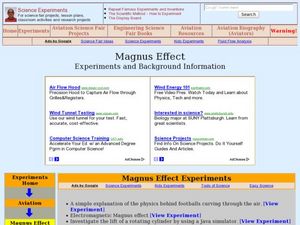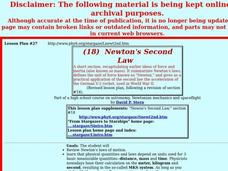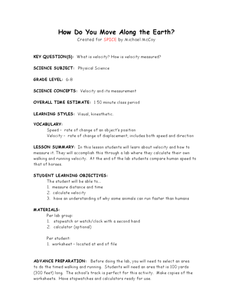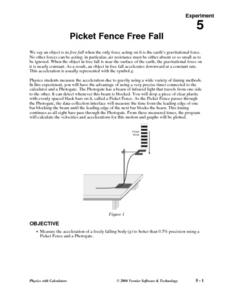Curated OER
Flicking With Force
Third graders are introduced to the concept of force and how it acts upon objects. In groups, they are given a ruler, ping-pong ball and golf ball and compare and contrast the force put on the balls when flicked by the ruler. To end...
Curated OER
Sand in Bottles
Eighth graders calculate the speed of bottles as they roll down a ramp with varying amounts of sand inside. Using their data, 8th graders estimate speed of three labeled bottles with different amounts of sand and compare those results...
Curated OER
Velocity and Acceleration
Twelfth graders look at local speed limits and traffic controls and see if they are reasonable. They plot the displacement and time to represent velocity, develop a plan for improving the current system, and organize experimental...
Curated OER
Why Use Seat Belts?
Students explore reasons why using a seat belt is a safe choice while riding in a car. In this physics/safety lesson, students set up and observe a doll with and without a seat belt moving down a ramp in a dynamics cart. Collision...
Curated OER
Friction Restriction: Creating a Design Plan to Redesign the Tread of Tennis Sneakers to Increase Friction
Learners evaluate the friction of tennis sneakers and redesign them to increase friction. In this physics lesson, students calculate starting, sideways and forward stopping friction. Using quantitative data, they prove that redesigning...
Curated OER
Exploring Simple Machines
Students investigate simple machines. In this simple machines lesson, students study how simple machines work. Students determine the function of various simple machines.
Curated OER
Magnus Effect
Students examine the Magnus effect and its history. In this forces lesson students investigate the lift of a rotating cylinder.
Curated OER
Charting Seasonal Changes
Students research the Earth's patterns of rotation and revolution, create a chart and graph of these patterns and use them to explain the causes of night and day and summer and winter.
Curated OER
Newton's Second Law
Students examine how physical quantities and laws depend distance, mass and time. They examine the MKS system; meter, kilogram and second, for doing calculations.
Curated OER
A Worksheet About Newton's Laws
In this Newton's laws worksheet, students review the law of inertia, the law of acceleration, and the law relating force to acceleration. This worksheet has 10 short answer questions.
Curated OER
The Ideal Gas
In this ideal gas worksheet, students read about the conditions necessary for an ideal gas to exist. They also read about the deviations from the ideal gas situation and answer four questions about ideal gases.
Curated OER
How Do You Move Along the Earth?
Middle schoolers determine their own walking and running velocity. In this physics lesson, students calculate velocity using distance and time information. They compare human and animal speeds.
Curated OER
Where the Rubber Meets the Road
Eighth graders examine two different types of tires and the effects of different factors on the amount of force needed to overcome sliding friction such as when the vehicle tries to stop.
Curated OER
Simple Machines
First graders discuss work, force, and energy. They study how work is done. Students discuss various types of work that are done. They act out how work is done. Student draw pictures of types of work they have done.
Curated OER
Tennis Triangle
Students calculate the height of a tree or flagpole. They measure the shadow of the tree or flagpole and the length of a shadow of a meterstick. Using similar triangles, calculate the heigh. Devise two additional ways in which to measure...
Curated OER
Picket Fence Free Fall
Students measure acceleration using a Picket Fence and a Photogate. In this physics lesson, students drop an object and measure the acceleration of the object free falling. They log their data using the TI.
Curated OER
A Quiz About Newton's Laws
In this Newton's laws worksheet, students review the definitions of the law of inertia, law of acceleration, and the law that relates force to acceleration. This worksheet has 10 short answer questions.
Alabama Learning Exchange
This Is How We Roll!
Students research how roller coasters work. For this physics lesson, learners research the history of roller coasters and the safety factors in the design of a roller coaster on the website www.learner.org/exhibits/parkphysics. They...
Curated OER
Helium Balloon Race
Students determine the force of a helium balloon that allows it to rise a specific distance. In this helium activity students calculate the amount of paper needed to construct a weight and determine the density of a piece of...
Curated OER
Soda Straw Rocket Activity
Students construct a rocket using soda straw. In this physics lesson, students determine the nose cone length that produces the best rocket. They explain the importance of using a control in an experiment.
Curated OER
Super Scientist Quiz
In this science worksheet, students match each of the descriptions on the right to the correct scientist listed on the right. There are thirty scientists to identify and match on the sheet.
Curated OER
Newton Word Search
In this science worksheet, students find the words that are related to the laws of motion and the work of Sir Isaac Newton. The answers are found by clicking the button found at the bottom of the page.
Curated OER
Aristotelian and Newtonian Motion
High schoolers use a quotation from Einstein as a reference to categorize their descriptions as either Newtonian or Aristotelian. They discuss the idealized nature of the Newtonian approach. Students describe the events they observe...
Other popular searches
- Laws of Motion
- Force and Motion
- Light and Motion
- Newtons Laws of Motion
- Motion Picture
- Forces and Motion
- Newton's Laws of Motion
- Newton's First Law of Motion
- Elementary Force and Motion
- Projectile Motion
- Newton's Second Law of Motion
- Newton's Third Law of Motion

